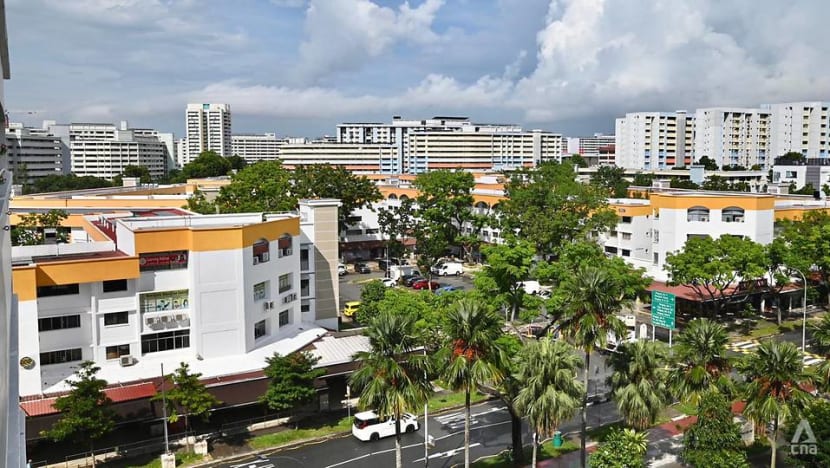Self-isolation for household members of COVID-19 close contacts a 'necessary' interim measure, say experts

Blocks 681, 683 and 684 Hougang Avenue 8 on Jun 4, 2021. (Photo: Hanidah Amin)
SINGAPORE: The new strategy of getting entire households to self-isolate at home if one member has been identified as a close contact of a COVID-19 case is necessary, but it is not likely to be a long-term approach, said infectious diseases experts.
The measure was announced on Monday (May 31) as authorities noted that with more infectious COVID-19 strains, transmission of the virus may occur more quickly among people who live together.
Members of the same household can be released from isolation only after the person under quarantine for being a close contact of a COVID-19 case tests negative.
READ: Household members of people under COVID-19 quarantine now required to self-isolate at home: MOH
“With this new highly transmissible (B16172) strain we have to do this to get ahead of the game. There are currently many linked cases that are not isolated at the time of diagnosis. This measure is targeting those people,” said senior consultant at the National University Hospital’s division of infectious diseases Professor Dale Fisher.
Prof Fisher, who is also chair of the national infection prevention and control committee at the Ministry of Health (MOH), described the approach as “very targeted and clever”.
The aim of the measure is to "move two steps ahead of the virus", said Professor Leo Yee Sin, executive director of the National Centre for Infectious Diseases (NCID).
At a media conference on Monday, Health Minister Ong Ye Kung provided numbers on COVID-19 cases who were linked to previous infectious but were not quarantined.
They made up 21 per cent of the 182 cases reported between May 17 and 23 and a quarter of the 136 cases in the next seven days, he said.
He added that close to 70 per cent of all linked new cases are due to household transmissions.
READ: Singapore ‘nudging’ in right direction with drop in unlinked cases over past two weeks: Ong Ye Kung
"Network ringfencing becomes more necessary now than previously” with new variants that are more transmissible, said dean of the National University of Singapore’s Saw Swee Hock School of Public Health Professor Teo Yik Ying.
“The incubation period may be as short as one or two days, and so household contacts may also be infected and be contagious before contact tracing can catch up,” he added.
STRATEGY LIKELY TO BE TEMPORARY
Prof Teo said that while this approach will help in the short-term to “keep up or even stay ahead of the transmissions happening within the community”, it is unlikely to be the long-term strategy that Singapore will adopt.
“I expect this strategy will be eased when the vaccination uptake in Singapore is sufficiently high,” he said.
READ: Singapore accelerates national COVID-19 vaccination programme, students the next group to be inoculated
Prof Fisher similarly said that as more get vaccinated, “we will become less dependent on measures such as these”.
Professor Paul Tambyah, president of the Asia Pacific Society of Clinical Microbiology and Infection, said that the key to controlling the virus remains mass vaccination.
“These strategies may help in the interim but the focus on expanding vaccination is key,” he said.
As for the impact of the strategy, Prof Fisher said Singapore should see the number of COVID-19 diagnoses made outside of quarantine fall in “even just a few days” while Prof Tambyah said the traditional approach is to wait for one incubation period or 14 days to see the effectiveness of any measure.
“We would be able to see results near the end of Phase 2 (Heightened Alert) in mid-June,” he added.
READ: Residents at Hougang block begin second round of mandatory COVID-19 testing
CHALLENGES OF THE STRATEGY
While the strategy is likely to slow transmission within the community, it is not without challenges.
These include getting buy-in from people as the measure is not mandated by law, Prof Fisher said.
“But they need to know that they may be saving Singapore from more stringent measures. If one of their family members is a contact then all household members should stay home until cleared as they could be the next link in the chain of transmission,” he said.
Prof Teo noted that the main challenge is the inconvenience to the entire household as they will need to rely on others to deliver food, medication and other essential items.
“Compliance (with the measure) may be patchy,” he added.
Job security may be another concern for some, said Prof Tambyah, adding that some people may not be willing to be identified as household contacts of first-degree contacts if they feel that their jobs would be in “jeopardy” due to self-isolation.
Having everyone confined at home would also increase the risk of transmission among them.
“While the wider public is protected, large families in small homes may have high rates of infection. This is what happened in the dormitories last year when there were many individuals in each room with even more sharing toilet and shower facilities,” Prof Tambyah said.
Self-isolation, which is an “efficient” strategy in limiting transmission, will have to go hand in hand with other strategies, said Professor of infectious diseases Laurent Renia from Nanyang Technological University’s Lee Kong Chian School of Medicine.
These include vaccination, social distancing and other public health measures.
“To contain any new waves, we have to continue testing to detect any new community and imported cases in the community and then isolate the positive cases,” he said.
BOOKMARK THIS: Our comprehensive coverage of the COVID-19 pandemic and its developments
Download our app or subscribe to our Telegram channel for the latest updates on the coronavirus outbreak: https://cna.asia/telegram












